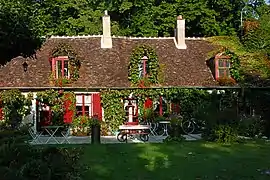Cour-Cheverny
Cour-Cheverny (French pronunciation: [kuʁ ʃəvɛʁni]) is a commune in the Loir-et-Cher department, Centre-Val de Loire region, France.[3] The commune's land extends across the Loire Valley and across the Sologne region. Its inhabitants are known as Courchois.
Cour-Cheverny | |
|---|---|
 | |
Location of Cour-Cheverny | |
 Cour-Cheverny  Cour-Cheverny | |
| Coordinates: 47°30′37″N 1°27′25″E | |
| Country | France |
| Region | Centre-Val de Loire |
| Department | Loir-et-Cher |
| Arrondissement | Blois |
| Canton | Vineuil |
| Intercommunality | CA Blois Agglopolys |
| Government | |
| • Mayor (2020–2026) | François Croissandeau[1] |
| Area 1 | 29.8 km2 (11.5 sq mi) |
| Population | 2,781 |
| • Density | 93/km2 (240/sq mi) |
| Time zone | UTC+01:00 (CET) |
| • Summer (DST) | UTC+02:00 (CEST) |
| INSEE/Postal code | 41067 /41700 |
| Elevation | 73–118 m (240–387 ft) (avg. 87 m or 285 ft) |
| 1 French Land Register data, which excludes lakes, ponds, glaciers > 1 km2 (0.386 sq mi or 247 acres) and river estuaries. | |
Toponymy
- The name Cour-Cheverny has its origins in the vulgar Latin word, curtis, meaning farm. It seems likely, then, that the village of Cour-Cheverny was once a large piece of land belonging to the nearby village of Cheverny.
- Over the years the village has had other names, such as Cour-en-Sologne, the name by which it was known up until the 19th century.
- The church was mentioned in 1145 as belonging to the Abbey of Bourgmoyen. It came under the diocese of Chartres at the time. Cour-Cheverny would have been a curtis, or farm, near to the small town of Cheverny, which began to grow in size and importance in the 6th century.
Sights
- The Château of Sérigny, la Sistière, Beaumont, Chantreuil, les Murblins, and la Taurie.
- La Borde is a renowned psychiatric clinic offering institutional psychotherapy treatments
- The 12th-century church of Saint-Aignan, which was altered in the 16th and 17th centuries, has a nave with two bays, two aisles, a semi-circular apse, arcades of two-centred pointed arches, ribbed vaulting with a keystone dating from 1609, an east-facing great door and a tall framed spire on a central bell tower.
- The Chapel of Sérigny.
- The Oratory of la Boide.
- The Conon Valley.
- The Beuvron, a 115 km long tributary of the Loire, that runs into the Loire at Candé-sur-Beuvron.
Population
| Year | Pop. | ±% |
|---|---|---|
| 1962 | 1,713 | — |
| 1968 | 1,724 | +0.6% |
| 1975 | 1,863 | +8.1% |
| 1982 | 2,130 | +14.3% |
| 1990 | 2,347 | +10.2% |
| 1999 | 2,555 | +8.9% |
| 2008 | 2,676 | +4.7% |
| 2013 | 2,750 | +2.8% |
Economy
Wine
The Cour Cheverny Appellation d'Origine Contrôlée (AOC) was recognized in 1997.[4] Geographically it corresponds to the commune of Cour-Cheverny and 10 other communes in the surrounding area. The single grape variety used is Romorantin, from which a dry, white wine is produced.
The Cheverny AOC, which was also recognized in 1997, covers a wider area but also includes the commune of Cour-Cheverny. The wines produced under this appellation are dry, white wines (the main grape variety being Sauvignon blanc), and red and rosé wines (the main grape variety being Gamay).
Events
- Weekly market day: Tuesday.
- Town's saint's day: Whit Monday;
- Town show: Easter and the Sunday following 15 August.
- Saint Vincent's Day, in honour of the patron saint of wine-growers, celebrated on 22 January.
- Bread Festival, first weekend in July.
- Flea Market, first weekend in August.
- Saint Cecilia's Day, in honour of the patron saint of musicians, celebrated on 22 November.
Sports
- Football
- Tennis
- Table Tennis
- Basketball
- Badminton
There is even a combined sports association that oversees and coordinates 10 different sections (Gymnastics, Badminton, Basketball, Dance School, Football, Judo, Petanque, Table tennis, Shooting and Cycling (Moorland to Lakeside, i.e. off-road)). The association is called the E.S.C.C.C. (Étoile sportive de Cour-Cheverny et Cheverny or Sporting Star of Cour-Cheverny and Cheverny.)
A gymnasium, built in the last ten years, is available for indoor activities.
Personalities
- Paul Renouard, the 19th-century artist, born in Cour-Cheverny
- Jean-François Deniau, a statesman and writer, 1928–2007.
- Alain Souchon, the singer, songwriter and actor
References
- "Répertoire national des élus: les maires". data.gouv.fr, Plateforme ouverte des données publiques françaises (in French). 2 December 2020.
- "Populations légales 2020". The National Institute of Statistics and Economic Studies. 29 December 2022.
- INSEE commune file
- INAO : Textes Consolides